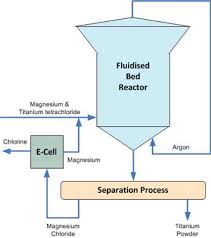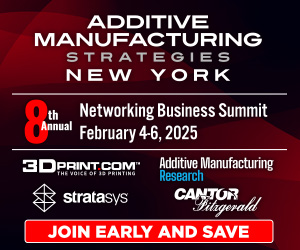As detailed in SmarTech Publishing’s latest Titanium Opportunities in Additive Manufacturing report, new and more affordable powder production methods could help counter-balance the elevated cost of the raw material. Today AM powders are produced either though costly gas atomization processes or through even costlier (and slower) plasma atomization processes.
As a means of reducing the high cost of titanium additive manufacturing powders, recent R&D is showing potentially disruptive outcomes for at least three methods for powder production powder. These could enable titanium to become a viable option for a wider range of industrial manufacturing sectors.
Straight to Titanium powder
In our latest report on the opportunities of titanium in AM, SmarTech Publishing describes electrolysis, a process for producing metal powders in development at Metalysis. Electrolysis offers both economic and environmental benefits over traditional metal production methods.
The process works by introducing metal oxides into a molten salt bath where it is electrolyzed to form metal powders and could result into one possible way to produce titanium powder directly from oxide feedstock, thereby eliminating the expensive and toxic Kroll process utilized to produce typical titanium feedstock forms which are then atomized. Electrolysis has the potential to significantly increase production volumes as it uses less energy and also promises that titanium and other innovative alloys can be tailored to have the desired properties for specific applications.
On August 16th Metalysis announced that it would increase its titanium and tantalum production to a commercial scale at its current site as it also takes on new high profile premises on the Advanced Manufacturing Park (AMP). If approved the facility could produce 20 tonnes per year of the cheaper titanium metal, with the potential to compete with and displace other products, such as complex steel and super alloys which currently have high production costs.
Metalysis has also recently completed a program with TWI, a UK leader in materials technology innovation that also has a base on the AMP, which demonstrated the feasibility of its powders for use in additive manufacturing of custom orthopedic hip implants.
SmarTech Publishing assesses that the long term viability of electrolysis as a powder production method for AM is still not fully clear. Its advantages, however, would be significant as it would result in a much less expensive mean of producing titanium powders, thus making it possible for AM to be used in cost-sensitive industrial segments including commercial automotive manufacturing.
Crushing the costs
A metal hydride process, where titanium hydride is created and subsequently crushed and milled into powder form, is also being experimented with in the context of AM powder. The hydride process relies on the brittle nature of metals such as titanium when they are exposed to hydrogen.
These powders aren’t normally suitable in as-made condition for AM, but can be used in further plasma atomization. Metal hydride could prove to be the most inexpensive mean of producing titanium powders for AM, even if it does require additional processing. SmarTech Publishing believes the process could be further developed to become a more direct solution on the future.
Another very new experimental process being developed for additive manufacturing and titanium powder is underway at Australian R&D organization CSIRO. The process, dubbed TiRO, and is a two-stage process for continuous powder production from thermally reduced titanium tetrachloride. TiRO is based on fluidized bed technology where solid particles suspended in a gas act like a fluid.

Captions: A basic schematics of the TiRO process developed by CSIRO for inexpensive and efficient titanium powder manufacturing (credits: CSIRO)
Because the TiRO process is attractive in terms of efficiency and production costs, it could drive titanium AM adoption in all industrial manufacturing segments, including aerospace and medical but also in automotive.
The CSIRO developed approach is fully automatable with rapid, simple plant start-up and shut-down; it can provide low inventory and low working capital, increased safety, thus enabling manufacturers to meet work-to-demand production schedules. Currently the team at CSIRO is refining the reactor design and building a scalable pilot reactor with production capacity of 2.0 kg/hour of titanium. The technology is poised for scale-up to commercial-scale production and will support development of a demonstration plant.
Powdered money

Captions: Current estimates by SmarTech Publishing see the average cost per Kg of titanium powder for AM to go from $517 in 2014 to $427 in 2024.
SmarTech Publishing believes lower costs in titanium powders will help to drive demand. The exact impact of powder production on the cost per one Kg of titanium powder are likely to vary significantly over time due to the development and fine tuning of manufacturing processes.
As it stands today, SmarTech Publishing sees the price of 1 Kg of titanium and titanium alloy powder to go from a price of $517 (in 2014) to about $472 in 2019 and then to $427 in 2024. This would represent an overall 17.4% decrease, over the course of 10 years, on the average price per one Kg. Within this price estimate, SmarTech is forecasting global titanium’s AM related revenues to grow by over 17 times ($48 million to $787 million). If new titanium powder manufacturing methods are able to deliver on their potential, this may turn into a very conservative estimate.
About SmarTech Publishing’s Titanium Report
Titanium Opportunities in Additive Manufacturing: A new specialty market report from SmarTech Publishing is the first of its kind to explore opportunities and considerations specifically for titanium and titanium alloys, was released in October 2015. Titanium is becoming one of three premiere metal group opportunities for additive manufacturing systems of numerous types, sought after primarily for its high strength to weight ratio, biological inertness, and other desirable properties when combined with additive layer manufacturing.
As a specialty study in a specific material, this report presents both market forecast data as well as critical market analysis for use of titanium in key industries adopting AM, as well as considerations for the future adoption and use in other applications. The primary opportunity factors related to the broader supply chain, primary providers of AM titanium powder and other forms, and analysis of the print technologies and powder production processes all combine to help business development and strategy professionals determine how to focus their efforts in titanium powder, parts, and print technologies.
If interested in purchasing a copy of this report, please email missy@smartechpublishing.com or you can purchase it directly on SmarTech Publishing’s website.
About SmarTech Publishing
SmarTech Publishing has published reports on most of the important revenue opportunities in the 3D printing sector including personal printers, low-volume manufacturing, 3D printing materials, medical/dental applications, aerospace and other promising 3D market segments. Our client roster includes some of the largest 3D printer firms, materials firms and investors in the world.
Since 2014, SmarTech Publishing has published dedicated, in-depth market studies focused on additive manufacturing opportunities in the metals sector.
Press Contact:
Lawrence Gasman
lawrence@smartechpublishing.com
434-872-0450

